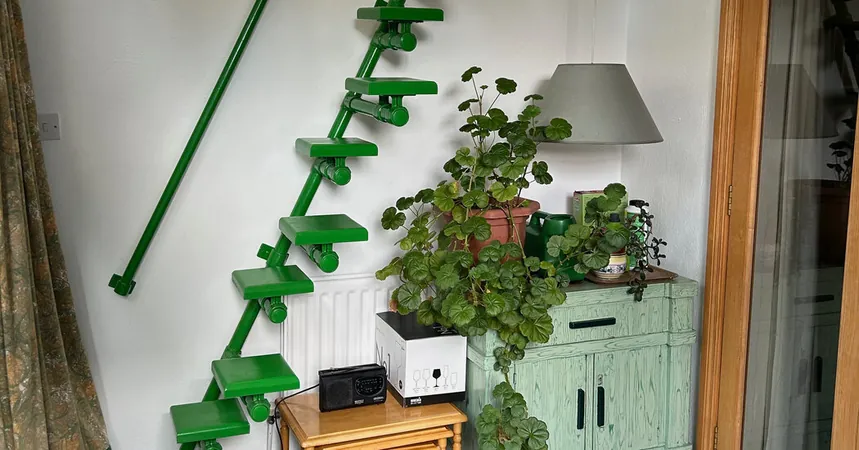
Take the ‘Death Stairs’ if You Dare: The Dark Side of Staircase Design
2024-11-13
Author: Jia
Introduction
Have you ever seen a staircase so dangerous it could be dubbed a "Death Stair"? Kevin Reid's childhood home features a bizarre bright green staircase constructed from pipe fittings, resembling a ladder more than a traditional stairway. Little did he know that this quirky design would capture a global audience, going viral after being posted in the now-popular Facebook group "Death Stairs," which boasts close to 800,000 members. This unique online community describes itself as a space where “ascension is perilous and descending is deadly.”
Criteria for Death Stairs
The criteria for a staircase to make it into this group are intriguing and diverse. From narrow triangular steps to glass spirals with mirrored walls, and even perilous wooden steps carved right into the steep cliffs of New Zealand, the more formidable the stairs, the better. Reid's childhood staircase, lacking guardrails and featuring slippery carpeting, fits the bill perfectly—celebrated for its perplexing and hazardous design attributes.
What Makes Stairs Dangerous?
What makes stairs worthy of the “Death Stairs” label? Stairs that terminate in gloomy basements or those running alongside a steep drop-off, guarded only by rusted barbed wire, are particularly famed among group members. This celebration of dangerously designed stairways has made plain the risks that often accompany these apparently mundane structures.
The Community Behind Death Stairs
The group’s creator, Lane Sutterby from Kansas, originally imagined a modest following. “I figured I’d have 10 or 15 people join, maybe some close friends and a couple of random strangers,” he recounts. With the help of four other moderators, Sutterby keeps the decorum intact, reminding group members to “be polite. This is just a page about stairs.”
Legendary Stairways
Interspersed among photographs of these ‘Death Stairs’ are legendary stairways from around the world, including the iconic steps of Pittsburgh and cultural landmarks like the pyramid at Chichen Itza in Mexico. Remarkably, homes dating back over a century often feature in the group’s collection, as do the elevated seats of modern arenas.
The History of Stairs
In fact, stairs have existed since prehistoric times. Architect John Templer, in his two-volume series “The Staircase,” highlights their duality as both beautiful and treacherous. His research underlines that stairway designs can indeed be hazardous; from 2000 to 2012, a staggering 61% of 578 stairways surveyed had at least one visible design flaw, according to studies published in the *International Journal of Architectural Research*.
Safety Concerns: The Hidden Dangers of Stairs
A 2018 study revealed some alarming statistics: an average of 1.1 million people were treated for stair-related injuries every year from 1990 to 2012. As Sara Harper, an assistant professor of exercise science at the University of Alabama in Huntsville, explains, falls can have catastrophic consequences, affecting one’s health, finances, and overall well-being. She advocates for safer stair designs, especially for vulnerable groups like older adults and visually impaired individuals.
Conclusion
The reality is that stairs are omnipresent in our daily lives, whether at home, work, or while exploring our communities. Yet, it’s often the seemingly simple structures we neglect that can pose the greatest risks. By understanding how to use stairs more effectively, we can minimize risks and elevate safety for all. So, the next time you come across a staircase that looks like it could lead to a disaster, think twice. You might just want to stick to the safe, well-designed routes—unless you're up for the dare of navigating the infamous ‘Death Stairs.’




 Brasil (PT)
Brasil (PT)
 Canada (EN)
Canada (EN)
 Chile (ES)
Chile (ES)
 España (ES)
España (ES)
 France (FR)
France (FR)
 Hong Kong (EN)
Hong Kong (EN)
 Italia (IT)
Italia (IT)
 日本 (JA)
日本 (JA)
 Magyarország (HU)
Magyarország (HU)
 Norge (NO)
Norge (NO)
 Polska (PL)
Polska (PL)
 Schweiz (DE)
Schweiz (DE)
 Singapore (EN)
Singapore (EN)
 Sverige (SV)
Sverige (SV)
 Suomi (FI)
Suomi (FI)
 Türkiye (TR)
Türkiye (TR)